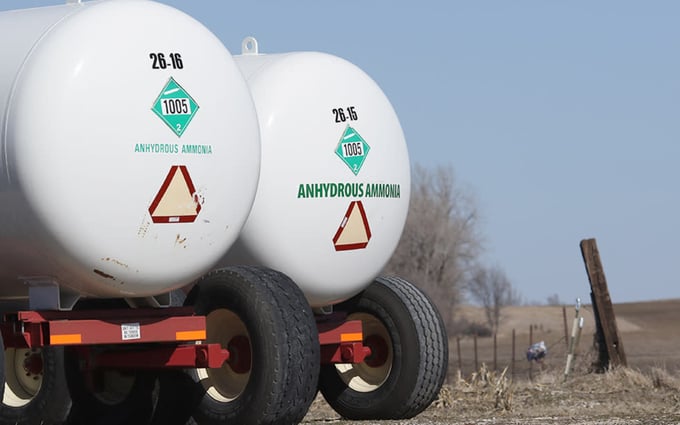January 1, 2026 | 01:35 GMT +7
January 1, 2026 | 01:35 GMT +7
Hotline: 0913.378.918
January 1, 2026 | 01:35 GMT +7
Hotline: 0913.378.918

Anhydrous ammonia is a common farm fertilizer that contributes to nitrate contamination of streams. Photo: Jared Strong.
The worry from farmers stems from fertilizer. According to data from the United States Department of Agriculture (USDA), nearly 90 percent of various fertilizer imports come from Canada, which could create a ripple effect not just for farmers, but for the broader food supply chain in the state.
“Is that good for our economy, to make our farmers who we rely on, who support us, who feed us — drive them out of business?” Gov. Kathy Hochul said.
According to the USDA, Canada and Mexico are the United States’ first and third largest suppliers of agricultural products, respectively, combining to over $56 billion worth from 2017 to 2021.
“With spring planting fast approaching, maintaining reliable cost-effective fertilizer supply chain is essential for a productive harvest and protecting American farmers from financial strain,” said Corey Rosenbush, president of The Fertilizer Institute — the nation’s leading voice of the fertilizer industry — in a statement Tuesday.Hochul agreed and said the most important element in fertilizer in the state fully comes from Canada.
“So, they’re laying down the fertilizer in April. Guess what happens in April?” Hochul said. “The agricultural tariffs are expected to go into place.”
Members of the Northeast Organic Farming Association (NOFA) of New York said fertilizer isn’t the only concern.
“The cost of parts, the cost of inputs [is] going up for farmers, tractors, machinery, all of these things,” said NOFA Communications Manager Samantha Kemnah.
“[There are] specific concerns about folks that import feed or other things from Canada across the border because we’ve got a lot of organic farmers that live right up on the Canadian border,” said NOFA educator Francesca McClure.
Rosenbush is asking President Donald Trump’s administration to provide a strategic “carveout” for Canadian fertilizers from these tariffs, adding, “affordable supply of fertilizer is critical to maintaining global competitiveness of U.S. farmers, strengthening rural economies and keeping food prices in check.”NOFA said there could be a positive to these tariffs, like consumers buying from local organics instead of overpriced big grocers.
“Consumers can consume better food, support their local economies, support local farm families, is to buy community supported agriculture share, shop up at the farmer’s market,” Kemnah said. “You’re actually supporting someone’s livelihood that way.”
wivb

(VAN) Chocolate lovers will not see immediate relief at the checkout despite a sharp drop in global cocoa prices this year.

(VAN) Most row crop farmers battled elevated production costs which, when coupled with low commodity prices, made profitability challenging in 2025.
/2025/11/24/3616-2-141832_513.jpg)
(VAN) FSC certification has helped increase the value of thousands of hectares of planted forest timber under the management of the Xuan Loc Protection Forest Management Board, particularly in terms of selling prices.

(VAN) More than 100 shoppers queued for a chance to get a kilo or so of Japanese rice for 500 yen ($3.32) by heaping as much grain into a small wooden box as possible.

(VAN) Benchmark international prices of milled declined in October as harvests started or improved in some parts of the globe.

(VAN) Show cause orders will be issued to retailers who sell imported rice at prices exceeding the maximum suggested retail price (MSRP) of P43 per kilo, Philippines Agriculture Secretary said in a statement on Thursday.

(VAN) Coffee prices on October 20, 2025, remained stable domestically, trading at 113,500–114,500 VND/kg. Similarly, global coffee prices also moved sideways.